Have you submitted your presentation? Four weeks left…
Abstract submission for the 2014 conference closes in four weeks. The clock is now ticking if you haven’t yet done so. What is your paper? Are you in a symposium? Do you prefer participating in a forum panel discussion, a three-minute forum or an electronic symposium? Do you prefer presenting a poster rather than a paper this year? If so, you should get a place of choice in the Convention Centre as we encourage this type of participation. Oh, by the way, did you know that the Québec City Convention Center is the only one in Canada offering free hi-speed wifi to conference attendees?
We have revamped the submission process to make it more transparent and user friendly for you. You can go straight there from the conference home page: http://www.sha2014.com/index.html. Have a look and let us know if this move from traditional practice suits your needs.
This year, presentations are being grouped into several themes. It will thus be easier for you to fit your paper into a slot corresponding to your interests if you aren’t already participating in a organized session. This is what you will see: Archaeological Methods; Diaspora Archaeology; Environmental and Landscape Archaeology; First Nations Archaeology; Identity and Community Archaeology; Information Technology; Legislation and Archaeological Practice; Material Culture Studies; Military Archaeology; Other; Regional Studies; Theory; Underwater and Maritime Archaeologies; Urban Archaeology.
Once into the category that interests you, you can explore sessions that have been entered into the system or that the conference committee proposes for you. Are you interested in organizing a session on one of the following subjects: The Ethics of Archaeological Practice; Historical Archaeology and the Media; Commercial and Governmental Archaeology: New laws, new practices; Archaeology and UNESCO World Heritage Sites; New Research in Material culture studies: Ceramics; Historical Archaeology as Anthropology; globalization and environmental archaeology; The Historical archaeology of Central America and the Caribbean; Who owns the past: sacred sites, battlefield archaeology, sites of pain, difficult heritage. Should none of these sessions tickle your fancy, you can propose a new one.
We hope this new process and a simplified interface will make the submission process easier for you and that it will result in a strong and interesting conference for all. Contact the Conference Committee through our web site at www.sha2014.com should you have any comments on the submission process. There will be regular updates and contextual information on the SHA Facebook page. Don’t forget to follow the progression of the conference on Twitter as well at #sha2014. Both the Facebook page and the Twitter feed give you lots of opportunities to interact with conference organizers and other colleagues. We are looking forward to reading you there. And of course, we are particularly looking forward to seeing you in Québec City next January!
New Books for Review
Dear Colleagues,
The following books are available for review. If any of them pique your interest do let me know.
Rich Veit–SHA Book Reviews Editor rveit@monmouth.edu
All the King’s Horses: Essays on the Impact of Looting and the Illicit Antiquities Trade on Our Knowledge of the Past
Paula K. Lazrus and Alex W. Barker, eds.
The SAA Press, The Society of American Archaeology, Washington D.C.,
2012. 168 pp., index. $24.95 regular price, $19.95 SAA member discount price.
Archaeological Sites: Conservation and Management
Sharon Sullivan and Richard Mackay, eds.
The Getty Conservation Institute, Los Angeles, California,
2013. 736 pp. $70.00 cloth.
Becoming White Clay: A History and Archaeology of Jicarilla Apache Enclavement
B. Sunday Eiselt
The University of Utah Press, Salt Lake City, Utah,
2012. 320 pp., 23 B&W Illus., 31 line drawings, index. $45.00 cloth, $56.00 eBook.
Bijoux de pacotille ou objets de piété? Les bagues dites “jésuites” revisitées à partir des collections archéologiques du Québec
Caroline Mercier
Cahier d’archéologie du CELAT, Quebec, Canada,
2012. 87 figs., 16 tables.
Clanricards Castle: Portumna House, Co. Galway
Jane Fenlon, ed.
Four Courts Press, Portland, Oregon,
2012. 192 pp., glossary, bibl., index. $65.00 cloth.
Curating Human Remains: Caring for the Dead in the United Kingdom
Myra Giesen, ed.
The Boydell Press, Woodbridge,
2013. 197 pp., 22 figs., 2 tables, index. $99.00.
Custer, Cody, and Grand Duke Alexis: Historical Archaeology of the Royal Buffalo Hunt
Douglas D. Scott, Peter Bleed, and Stephen Damm
University of Oklahoma Press, Norman, Oklahoma,
2013. 232 pp., 63 B&W Illus., 2 maps, index. $24.95 cloth.
Duncluce Castle: History and Archaeology
Colin Breen
Four Courts Press, Portland, Oregon,
2012. 246 pp., full-color illus., 6 tables, glossary, bibl., index. €19.95 catalogue price, €17.95 web price.
Hawaii’s Past in a World of Pacific Islands
James M. Bayman and Thomas S. Dye
The SAA Press, The Society for American Archaeology, Washington D.C.,
2013. 29 figs., 5 tables, glossary, bibl., index. $24.95 regular price, $19.95 member discount price.
Historical and Archaeological Perspectives on Gender Transformations: From Private to Public
Suzanne M. Spencer-Wood, ed.
Springer, New York, New York,
2013. 430 pp., 66 illus., 16 illus. in color, index. $179.00 eBook, $229.00 hardcover.
Interpreting the English Village
Mick Aston and Chris Gerrard
Windgather Press, Oxbow Books, Oxford,
2013. 456 pp., 257 figs., bibl., index. $49.95 cloth.
Lightning in the Andes and Mesoamerica: Pre-Columbian, Colonial, and Contemporary Perspectives
John E. Staller and Brian Stross
Oxford University Press, New York, New York,
2013. 278 pp., 57 illus., 8 pp. color insert, index. $74.00 hardback.
Old Myths and New Approaches: Interpreting Ancient Religious Sites in Southeast Asia
Alexandra Haendel, ed.
Monash University Publishing
2012. 312 pp., $49.95 cloth.
Soils, Climate & Society: Archaeological Investigations in Ancient America
John D. Wingard and Sue Eileen Hayes, eds.
University Press of Colorado, Boulder, Colorado,
2013. 272 pp., 34 figs., 29 tables, list of contributors, index. $70.00.
Tales of Gotham, Historical Archaeology, Ethnohistory, and Microhistory of New York City
Meta F. Janowitz and Diane Dallal, eds.
Springer, New York, New York,
2013. 369 pp., 58 illus., 26 illus. in color. $139.00 eBook, $179.00 hardcover.
The Archaeology of the Prussian Crusade: Holy War and Colonisation
Alexander Pluskowski
Routledge, New York, New York,
2012. 427 pp., 85 figs., glossary, bibl.,index, $48.95 cloth.
The Cherokees of Tuckaleechee Cove
Jon Marcoux
The University of Michigan Museum of Anthropology Publications, Ann Arbor, Michigan,
2012. 296 pp., 136 figs., 60 tables, $33.00.
Uncovering History: Archaeological Investigations at the Little Bighorn
Douglas D. Scott
University of Oklahoma Press, Norman, Oklahoma,
2013. 272 pp., 53 B&W Illus., 1 map, $32.95 cloth.
A Student’s Perspective on the 2013 SHA Conference
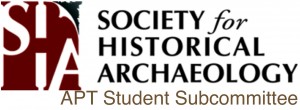 The SHA Conference in Leicester, England, was the experience of a lifetime! The idea of attending such an event as an undergraduate was exciting, but a bit intimidating. The reality of my experience was that the SHA is a community that truly welcomed students and provided arenas for us to network with archaeologists who have similar research interests and learn about current issues, ongoing research, and new technologies. Immediately after arriving at the University of Leicester for the conference I met two senior archaeologists with distinct research interests. They were welcoming and sincere in their interest in who I was and what I was interested in. Only in the conference setting can you have the opportunity to meet so many professionals from around the world who are doing archaeology! Within a few minutes of my arrival at the conference I felt more like I was among peers than a lowly undergraduate and I commend the members of the SHA for this.
The SHA Conference in Leicester, England, was the experience of a lifetime! The idea of attending such an event as an undergraduate was exciting, but a bit intimidating. The reality of my experience was that the SHA is a community that truly welcomed students and provided arenas for us to network with archaeologists who have similar research interests and learn about current issues, ongoing research, and new technologies. Immediately after arriving at the University of Leicester for the conference I met two senior archaeologists with distinct research interests. They were welcoming and sincere in their interest in who I was and what I was interested in. Only in the conference setting can you have the opportunity to meet so many professionals from around the world who are doing archaeology! Within a few minutes of my arrival at the conference I felt more like I was among peers than a lowly undergraduate and I commend the members of the SHA for this.
The presentations given at the conference covered a wide variety of topics. I enjoyed the breadth of topics as well as papers on sites close to home, which fit my own interests in colonialism, mining, and military history. I attended presentations on experimental archaeology in the re-creation of canons, talks on unfamiliar locations like Saint Eustatius in the Caribbean, fascinating underwater sites, Shakespearian theatre settings, and the presentation on vaginal douching in the late 19th and early 20th centuries by the student paper prize winner, Ashley Morton. There was certainly a topic to interest everyone!
The Conference presented opportunities to learn about contemporary issues for students in the field of historical archaeology. Thursday morning I attended a panel specifically for students, titled: Navigating the Field: Education and Employment in a Changing Job Market. The discussion was sobering at times, and I left a little discouraged, but after ruminating over the discussion, I found it to be very useful. The current job market is difficult, but I learned the importance of learning necessary job skills and the importance of making the most of your opportunities.
Another highlight of my conference experience was a symposium, titled: Reconsidering Archaeologies of Creativity, which was chaired by Dr. Scarlett. The discussant following the session was Dr. Krysta Ryzewski, of Wayne State University. The discussion format was unique and captivating because Dr. Ryzewski instead of presenting a paper synthesizing the work presented in the symposium she hosted a dialogue between her and the presenters that was excellent, and enlightening.
During the course of the conference I had many productive conversations. Some conversations resulted in possible opportunities for future work. One discussion focused on a potential summer field project. Just one example of the opportunities that came from my conference attendance, this highlights one of the most important reasons for a student to attend a conference… networking!
The benefits of attending extended beyond my time in Leicester. In reviewing my notes from the conference, I found several notations referring to different archaeological theories. Seeing the use of theory in presentations and experiencing the ensuing discussions sparked a fascination with archaeological theory, which was something I had only a rudimentary understanding of beforehand. I now find myself using every spare minute to study different theoretical subjects.
I strongly recommend that any student attending a conference attend as many student events as possible. I personally wish that I had attended more than I did. The people that you meet at these events are your future colleagues, and the relationships you create at the conference can lead to collaboration in the future. I was able to meet some great people at the Past Presidents’ reception, and I have maintained contact with several of them. I also spent much of the rest of the conference with two of the students I met that evening, and we had some great conversations in which I learned a lot about what a Master’s Program is all about.
Another tip I recommend students take advantage of is to visit the Technology Room. I spoke with Tim Goddard. We talked about how the Technology Room is designed to be an accessible place for people to learn from fellow archaeologists about the latest technologies, and their strengths and weaknesses. During my visit to the technology room I found that this was the case, the people manning the tables were accessible, and excited about the technologies on display.
A few more tips that I learned about the conference are: to bring business cards, plan to attend the talks that interest you as well as those on subjects you don’t know much about, and take good notes. Business cards are handy to hand out to different people that you meet even if you have to make your own. Going to papers on subjects you don’t know much about will expand your knowledge and possibly interests. For example, if you are interested in historical archaeology in the American West, attend some presentations on underwater archaeology, or European archaeology, you may find that you learn more from the different perspectives given in these talks than on presentations on subjects that follow your personal interests. While there your brain will be swimming with information by the end of the conference, by taking good notes you can sort things out after the conference.
Personally, attending the SHA conference opened doors I never imagined possible. During the conference, I had the opportunity to meet Dr. Doug Scott, who recently retired from the University of Nebraska-Lincoln. He gave a talk on a project he had completed at Pecos Pueblo, an area in which I have a lot of interest. When I returned home from the conference and was considering which institutions I would like to attend for graduate school, I decided to look at the University of Nebraska-Lincoln. The program seemed to fit my interests perfectly, so I chose to apply. I was accepted and will be attending their program in the fall. I was grateful to have Dr. Scott’s honest opinion of the University and I am appreciative of the time he took to discuss the graduate school process with me. These types of opportunities really make the whole conference experience invaluable.
My attendance at the conference would not have been possible without the help of Dr. Crowther at ASU who provided the financial assistance necessary to make the trip to England possible. I also have the deepest appreciation to Dr. Dick Goddard, and Tim Goddard for presenting the idea of attending the conference, putting me up in Leicester, and being amazing friends, teachers, and mentors. This has led me to some questions: for those of you who attended the conference in Leicester, did you receive any assistance to help you to participate in the conference? What are some resources out there to help with expenses? What were some of your conference experiences? How can we encourage more students to attend, and participate, in future conferences?
Why historical archaeology should pay attention to the Occupy movement
 Occupy and its offspring have brought issues that are of intrinsic interest to our discipline into the public consciousness in profound ways. I suggest that historical archaeologists have much to learn through a careful study of how Occupy has framed these issues, and much we could do to further advance them in the public mind.
Occupy and its offspring have brought issues that are of intrinsic interest to our discipline into the public consciousness in profound ways. I suggest that historical archaeologists have much to learn through a careful study of how Occupy has framed these issues, and much we could do to further advance them in the public mind.
History and issues
Occupy began with a series of meetings between small working groups and veteran political organizers in late summer 2011, culminating in a planned march and gathering in New York’s Zuccotti Park on September 17. After a series of increasingly public actions drew (generally negative) media attention, the movement spread organically to other large (and eventually, small) cities across the United States. By late October, groups that took the Occupy label had spread around the globe–the German “Blockupy,” for instance. Following both evictions and intentional withdrawal from public spaces in most cities during the winter, small actions resumed in Spring 2012, but more significantly, a number of issue-oriented movements in the spirit of Occupy have replaced long-term, place-based encampments. These include such diverse things as “Occupy the Police,” “Occupy Anthropology,” “Occupy Sandy” (a reference to the hurricane that struck the Northeastern U.S. in October 2012), and the “Rolling Jubilee” anti-debt movement. (For brief histories of Occupy, see the Al Jazeera English-produced Fault Lines documentary History of an Occupation, and A History of Occupy (Earle 2012), from which I have drawn most of the above summary.)
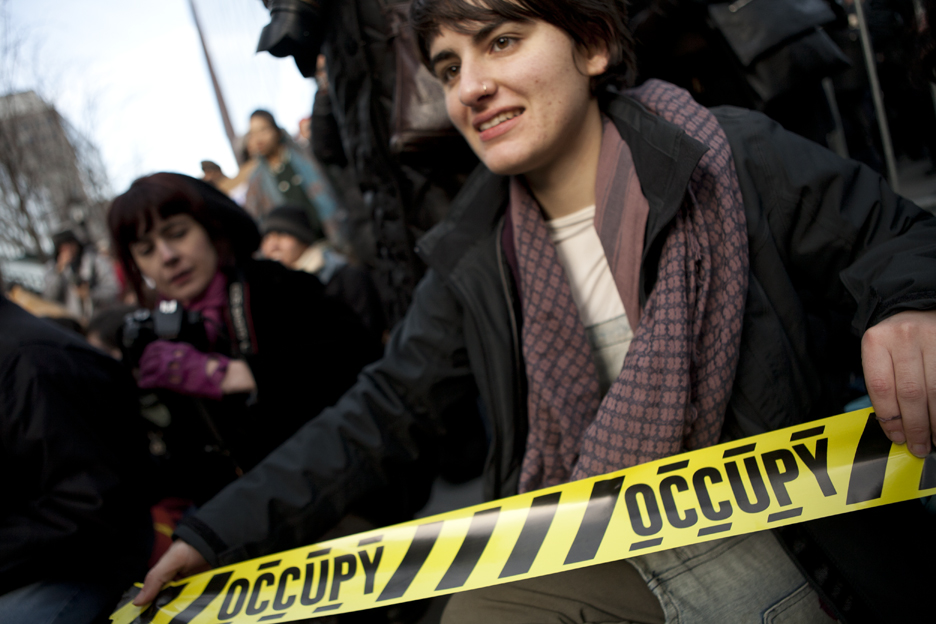 Occupy has always been a big-tent movement, both in terms of its membership and of the issues its activists raise (Earle 2012). This is a hallmark of consensus-based groups. Two themes stand out to me as fundamental to most of those who continue to organize under the Occupy banner: A focus on community formation and reproduction, especially in the interstices of the state; and an accessible, critical analysis of the social implications of global capitalism. In other words, “How do we validate intentional, interest-based social ties between people?” and “How do we demonstrate the ill effects of profit and exploitative labor on the daily lives of people in our communities?” Community-formation and reproduction, and the effects of capitalism, are significant parts of the research agendas of many of us working in this field (Matthews 2010), and Occupy has helped prime the public to be receptive to capitalism-centered theory and praxis (McGuire 2008) in ways that we have rarely seen.
Occupy has always been a big-tent movement, both in terms of its membership and of the issues its activists raise (Earle 2012). This is a hallmark of consensus-based groups. Two themes stand out to me as fundamental to most of those who continue to organize under the Occupy banner: A focus on community formation and reproduction, especially in the interstices of the state; and an accessible, critical analysis of the social implications of global capitalism. In other words, “How do we validate intentional, interest-based social ties between people?” and “How do we demonstrate the ill effects of profit and exploitative labor on the daily lives of people in our communities?” Community-formation and reproduction, and the effects of capitalism, are significant parts of the research agendas of many of us working in this field (Matthews 2010), and Occupy has helped prime the public to be receptive to capitalism-centered theory and praxis (McGuire 2008) in ways that we have rarely seen.
Implications
The interests of Occupy and historical archaeology align in ways that go beyond our shared intellectual concern with daily lives and global forces. We are part of what Occupy has constructed as “the 99 percent,” whether we work in academic settings that are increasingly under neoliberal assault (Agger 2004), in the public sector that is being squeezed under the weight of flawed austerity policies, or in cultural resource management with its rigid profit motive and accompanying class structure (McGuire 2008). Occupy’s concerns are our concerns, writ both large and small, in the communities in which we live and work.
 Moreover, both Occupy and historical archaeology attempt to make manifest (sensu González-Ruibal 2008) that which is hidden. For the former, it is how such things as the machinations of global political economy impact communities struggling with, say, disaster recovery. For us, making manifest is our stock in trade, encompassing everything from excavation and documentary research to publications and talks aimed at, as the saying goes, “giving voice to the voiceless.” Occupy and its offspring challenge us to go beyond simply revealing what is hidden, to the realm of praxis. Occupy Sandy, for instance, continues to organize help and build community through mutual aid work in New York and New Jersey neighborhoods where state and federal aid have not met the need. As of this writing, the Rolling Jubilee has bought and forgiven over $11 million in medical debt. Both of these examples demonstrate action that arose after careful study of a specific social problem, one that has its genesis in largely hidden forces but directly impacts real lives in real communities. That action in turn works to critique the system that nurtures and sustains the problem itself.
Moreover, both Occupy and historical archaeology attempt to make manifest (sensu González-Ruibal 2008) that which is hidden. For the former, it is how such things as the machinations of global political economy impact communities struggling with, say, disaster recovery. For us, making manifest is our stock in trade, encompassing everything from excavation and documentary research to publications and talks aimed at, as the saying goes, “giving voice to the voiceless.” Occupy and its offspring challenge us to go beyond simply revealing what is hidden, to the realm of praxis. Occupy Sandy, for instance, continues to organize help and build community through mutual aid work in New York and New Jersey neighborhoods where state and federal aid have not met the need. As of this writing, the Rolling Jubilee has bought and forgiven over $11 million in medical debt. Both of these examples demonstrate action that arose after careful study of a specific social problem, one that has its genesis in largely hidden forces but directly impacts real lives in real communities. That action in turn works to critique the system that nurtures and sustains the problem itself.
In short, Occupy demonstrates praxis–a dialectic of analysis, critique, and action. Our field excels at summoning new knowledge from its hiding places, but knowledge and critique without action is of questionable utility. An Occupy-inspired historical archaeology would rest on all three legs of praxis. So what might some examples look like in practice?
Occupying historical archaeology
In short, it would be an archaeology that seeks out the hidden lives disrupted by capitalism, by non-local politics, by market relations (Matthews 2010: 14), by government policies that prioritize austerity over people’s well-being (Buchli and Lucas 2001).
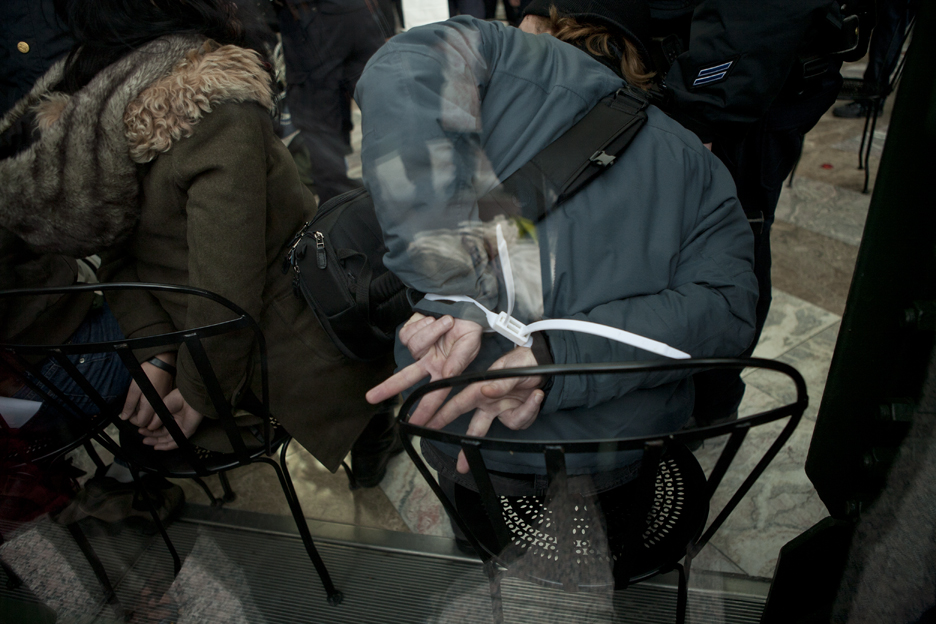 These disrupted lives are all around us, in our own communities. They’re being lived by perhaps thousands of homeless in the storm sewers beneath Las Vegas, as well as in a network of self-dug (and quickly demolished by police) tunnels in Kansas City. They’re being lived by people being sent to jail for unpaid debts. They’re being lived by people forced into tent cities in some of the wealthiest regions of the United States.
These disrupted lives are all around us, in our own communities. They’re being lived by perhaps thousands of homeless in the storm sewers beneath Las Vegas, as well as in a network of self-dug (and quickly demolished by police) tunnels in Kansas City. They’re being lived by people being sent to jail for unpaid debts. They’re being lived by people forced into tent cities in some of the wealthiest regions of the United States.
This would be an archaeology that is multidisciplinary, multi-sited, and politically engaged. It would be one that begins in the present but does not necessarily end there.
There are examples. These themes run through much work on the so-called “contemporary past.” They hum throughout Jason De León’s work on the Undocumented Migrant Project. And they are brought out vividly in the work of Rachael Kiddey and her team on homelessness in Bristol, which enlists the homeless in a reflexive archaeology aimed at understanding the material and social causes and experiences of living on the streets (Kiddey and Schofield 2011).
None of the above, to my knowledge, position themselves as aligned with Occupy–nor do I suggest that they, or anyone else, must. But they’re generating knowledge and critique and action that fall directly in line with the key themes that Occupy and its offspring are raising. A sense of nearness and solidarity with the people being studied is key (“we are the 99 percent”). Action that flows from praxis must be collective action involving the people who live under the weight of the social problem in question, otherwise it could be co-opted to reinforce alienation.
I suggest that our field has the ability to bring unique knowledge, analysis, and methods to bear on revealing present-day lives and experiences of people pushed to the margins. This would be useful knowledge and critique to activists who cross-cut social lines, united by class interests, and experienced in organizing community-based aid and consciousness-raising. Occupy is pointing us toward an object, and it welcomes new sources of willing bodies and minds. Are we willing to listen, study, and act?
References
Buchli, Victor, and Gavin Lucas
2001 The Archaeology of Alienation: A Late Twentieth-Century British Council House. In Archaeologies of the Contemporary Past, Victor Buchli and Gavin Lucas, editors, pp. 158-168. Routledge, London.
Earle, Ethan
2012 A Brief History of Occupy Wall Street. Rosa Luxemburg Stiftung, New York.
González-Ruibal, Alfredo
2008 Time To Destroy: An Archaeology of Supermodernity. Current Anthropology 49(2): 247-279.
Kiddey, Rachael, and John Schofield
2011 Embrace the Margins: Adventures in Archaeology and Homelessness. Public Archaeology 10(1): 4-22.
Matthews, Christopher N.
2010 The Archaeology of American Capitalism. University Press of Florida, Gainesville.
McGuire, Randall H.
2008 Archaeology as Political Action. University of California Press, Berkeley.
All Images are by Jessica Lehrman from the Occupy Wall Street Flickr Archive and are licensed under the Creative Commons Attribution-NonCommercial.
The Primal Fear: Historical Archaeology and De-Accessioning
 In 1996, former SHA Curation Committee Chair Bob Sonderman (Museum Resource Center, National Park Service) argued that archaeologists’ commitment to preserve an astounding volume of artifacts has fostered “an overwhelming sense of primal fear when the thought of deaccessioning archeological material is raised.” Archaeologists do indeed have an emotionally charged approach to collection and curation of artifacts: We value every object in an assemblage as an element in a complex historical narrative; we are especially committed to the notion that “small things” matter; and we have faith that future scholars may one day find fresh insights in old things. Yet preserving everything may be neither a practical strategy nor an especially constructive research method.
In 1996, former SHA Curation Committee Chair Bob Sonderman (Museum Resource Center, National Park Service) argued that archaeologists’ commitment to preserve an astounding volume of artifacts has fostered “an overwhelming sense of primal fear when the thought of deaccessioning archeological material is raised.” Archaeologists do indeed have an emotionally charged approach to collection and curation of artifacts: We value every object in an assemblage as an element in a complex historical narrative; we are especially committed to the notion that “small things” matter; and we have faith that future scholars may one day find fresh insights in old things. Yet preserving everything may be neither a practical strategy nor an especially constructive research method.
Historical archaeologists routinely excavate massive assemblages, and we nearly always consign them to storage awaiting the analysis of future scholars. As a result, storage spaces are overflowing in many repositories, and dwindling budgets have restricted spaces and in some cases eliminated collections managers if not whole projects. Many repositories have no especially reliable record of the materials in their possession, others cannot clearly document their ownership of holdings, and some are not remotely close to legal curation standards. Archaeologists are well-trained in excavation and material analysis, but curation and placing things in collections—much less maintaining them afterward and managing their long-term storage or even de-accession—have not occupied much of our disciplinary attention.
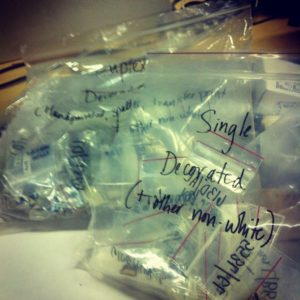 On the list of fascinating archaeological research subjects, curation may not normally jump to many peoples’ minds. Collections scholars have rigorous curation, acquisition, and de-accession practices and standards, but most archaeologists have not received particularly systematic collections management training and may not comprehend the broad challenges facing archaeological collection managers. More than 30 years ago William Marquadt, Anta Modet-White, and Sandra C. Sholtz proclaimed that there was a crisis in the curation of American archaeological collections, but the oft-ignored question of archaeological curation remains awkwardly evaded today.
On the list of fascinating archaeological research subjects, curation may not normally jump to many peoples’ minds. Collections scholars have rigorous curation, acquisition, and de-accession practices and standards, but most archaeologists have not received particularly systematic collections management training and may not comprehend the broad challenges facing archaeological collection managers. More than 30 years ago William Marquadt, Anta Modet-White, and Sandra C. Sholtz proclaimed that there was a crisis in the curation of American archaeological collections, but the oft-ignored question of archaeological curation remains awkwardly evaded today.
More than a half-century of enormously productive historical archaeology fieldwork has left us with a voluminous material heritage to manage. Some long-term repositories are literally full, are unable to accommodate more collections, have decided to no longer curate archaeological assemblages, or have had their curatorial staff laid off. Increasingly more repositories charge archaeologists to store materials, but we rarely if ever include particularly concrete financial curation budgets in our project designs.
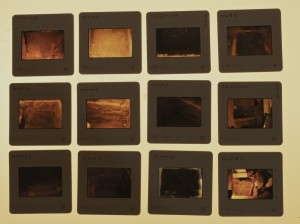 The challenges extend throughout the world. For instance, in 2008 the Europae Archaeologiae Consilium hosted a symposium on archaeological archiving that examined dilemmas familiar to many North American historical archaeologists, including the challenges of a vast range of archaeological recording practices and curatorial standards, the need to establish digital archive standards, and management conditions that fail to satisfy the Valleta Treaty (also known as the European Convention on the Protection of the Archaeological Heritage). In Britain, the Institute for Archaeologists Council has a Special Interest Group for Archaeological Archives that aspires to develop curatorial best practices and advocate on archaeological archives issues.
The challenges extend throughout the world. For instance, in 2008 the Europae Archaeologiae Consilium hosted a symposium on archaeological archiving that examined dilemmas familiar to many North American historical archaeologists, including the challenges of a vast range of archaeological recording practices and curatorial standards, the need to establish digital archive standards, and management conditions that fail to satisfy the Valleta Treaty (also known as the European Convention on the Protection of the Archaeological Heritage). In Britain, the Institute for Archaeologists Council has a Special Interest Group for Archaeological Archives that aspires to develop curatorial best practices and advocate on archaeological archives issues.
On one level, curation dilemmas raise practical financial and methodological challenges. Narrowly defined, we minimally face a practical resource dilemma in the expense of storage, but this has methodological implications on what we actually collect in the field, de-accessioning risks taking aim disproportionately on historic artifacts, and curation policies certainly will shape the collections we leave available to subsequent scholars.
On another level, de-accession poses a particularly complex philosophical challenge to our stewardship of the archaeological past. We have implicitly linked our stewardship to saving everything, but this avoids acknowledging the state in which many collections are held, and it ignores the financial and material realities of managing such resources. Museums have long de-accessioned holdings as a normal part of collections management; that is, museums reassess their collections and permanently remove objects that are redundant, duplicates, deteriorated, or outside their mission. Library archivists likewise manage their collections by regularly reappraising collections and implementing formal de-accession policies based on factors such as infrequent use. In contrast, archaeologists have normally assumed that artifact collections are simply placed in permanent storage. Responsible scholarship demands trained curatorial professionals working in costly facilities, but most of us do not have curatorial training and are faced with less-than-ideal repository conditions. There is no absolutely objective process to decide what might one day be important to scholars, so de-accession is especially threatening to those of us who feel responsible for passing on organized and rich collections to future researchers. However, we need to recognize that de-accession is one element in broad management strategies well-developed by museums and archives faced with many of the same challenges archaeologists face.
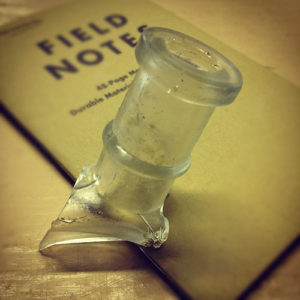 One final dimension of this curation crisis that remains awkwardly avoided is the lack of research that is being conducted in archaeological repositories. Esther White and Eleanor Breen’s thoughtful 2012 assessment analysis of Virginia’s archaeological repositories revealed that more than two-thirds of Virginia’s archaeological repositories are never used for research. If we are going to preserve so many collections then scholars need to use those collections and not simply view them as dead storage. The lack of more collections research may reflect an archaeological culture that grants professional prestige to scholars who conduct their own field projects. American academics administering student research, for instance, often encourage graduate students to conduct their own digs, which provides some control over their data and demonstrates their mastery of a breadth of archaeological skills. Part of the reluctance to do collections research probably also reflects our disciplinary celebration of the field experience itself and a tendency to paint “dirt archaeology” as the heart of archaeological identity.
One final dimension of this curation crisis that remains awkwardly avoided is the lack of research that is being conducted in archaeological repositories. Esther White and Eleanor Breen’s thoughtful 2012 assessment analysis of Virginia’s archaeological repositories revealed that more than two-thirds of Virginia’s archaeological repositories are never used for research. If we are going to preserve so many collections then scholars need to use those collections and not simply view them as dead storage. The lack of more collections research may reflect an archaeological culture that grants professional prestige to scholars who conduct their own field projects. American academics administering student research, for instance, often encourage graduate students to conduct their own digs, which provides some control over their data and demonstrates their mastery of a breadth of archaeological skills. Part of the reluctance to do collections research probably also reflects our disciplinary celebration of the field experience itself and a tendency to paint “dirt archaeology” as the heart of archaeological identity.
Nevertheless, perhaps the most ambitious comparative research projects can only be conducted in museum collections. Beyond the scholarly rigor such work can provide, leaving so many collections to languish means many assemblages will only be reported in technical reports. Collections research has not always been especially well-funded by granting agencies, but the cost of collections projects is often much more modest than a single field season excavation. I personally traveled to do collections research in the UK in London and York based on a relatively modest grant from my University, and that provided me the chance to work with an especially rich sample of materials I could never have hoped to find in any single excavation anywhere.
 The SHA’s goal has not been to impose codes of conduct on archaeologists and managers; rather, we simply hope to encourage responsible and informed practice and frank acknowledgement of curation challenges as part of all field archaeological research. We need to think responsibly about the final curation of the materials we excavate, and a realistic management plan should be in every research proposal. The SHA has strongly discouraged collections de-accessioning, but we may need to develop more concrete processes to confront the challenges many repositories face, and obviously many archaeologists and collections managers are wrestling with comparable issues. All of our research proposals have some statement on the collection methods and long-term storage of artifacts, but some are a bit ambiguous, and even the best-planned curation plan can be derailed by new policies. We share a common belief that every artifact has some research potential, but we need to soberly weigh the economic and practical realities of storing every object we recover into perpetuity, and we need to acknowledge that a new generation of archaeologists will eventually inherit scores of assemblages gathering dust. We face many common challenges, and we stand the best chance of developing responsible strategies if field archaeologists and collections managers share our experiences, challenges, and real and proposed solutions.
The SHA’s goal has not been to impose codes of conduct on archaeologists and managers; rather, we simply hope to encourage responsible and informed practice and frank acknowledgement of curation challenges as part of all field archaeological research. We need to think responsibly about the final curation of the materials we excavate, and a realistic management plan should be in every research proposal. The SHA has strongly discouraged collections de-accessioning, but we may need to develop more concrete processes to confront the challenges many repositories face, and obviously many archaeologists and collections managers are wrestling with comparable issues. All of our research proposals have some statement on the collection methods and long-term storage of artifacts, but some are a bit ambiguous, and even the best-planned curation plan can be derailed by new policies. We share a common belief that every artifact has some research potential, but we need to soberly weigh the economic and practical realities of storing every object we recover into perpetuity, and we need to acknowledge that a new generation of archaeologists will eventually inherit scores of assemblages gathering dust. We face many common challenges, and we stand the best chance of developing responsible strategies if field archaeologists and collections managers share our experiences, challenges, and real and proposed solutions.
All images appear courtesy Terry Brock’s flickr page
Links
Compare the materials on the January 2011 SHA Forum on Collections Management, which included a preliminary working statement on collections management.
There are numerous state and federal guidelines for Archaeological Curation Standards, which of course include the SHA Standards and Guidelines for the Curation of Archaeological Collections. The Society for American Archaeology includes links to a wide range of Archaeological Ethics Codes, Charters, and Principles.
The National Park Service inventories some standards and research on archaeological curation on their Sources of Archaeological Curation Information page.
British scholarship on these issues can be found at the Institute for Archaeologists Archaeological Archives Group and their Archaeological Archives Special Interest Group facebook page. They hold Regional Archives Workshops to promote best practices in archaeological archives management.
European standards for archaeological archives can be found at ARCHES (Archaeological Resources in Cultural Heritage: a European Standard) and on the ARCHES web page.
References
Bustard, Wendy
2000 Archaeological Curation in the 21st Century, or, making Sure the Roof Doesn’t Blow Off. CRM 5:10-15.
Childs, S. Terry
1999 Contemplating the Future: Deaccessioning Federal Archaeological Collections. Museum Anthropology 23(2):38-45.
Childs, S. Terry and Karolyn Kinsey
2003 Costs of Curating Archaeological Collections: A Study of Repository Fees in 2002 and 1997/98. Studies in Archeology and Ethnography, National Park Service.
Doylen, Michael
2001 Experiments in Deaccessioning: Archives and On-Line Auctions. The American Archivist 64(2):350-362. (subscription access)
Greene, Mark A.
2006 I’ve Deaccessioned and Lived to Tell about It: Confessions of an Unrepentant Reappraiser Archival Issues 30(1):7-22.
Patrick D. Lyons, E. Charles Adams, Jeffrey H. Altschul, C. Michael Barton, and Chris M. Roll
2006 The Archaeological Curation Crisis in Arizona: Analysis and Possible Solutions. Unpublished report prepared by the Curation Subcommittee of the Governor’s Archaeology Advisory Commission.
Marquardt, William H., Anta Montet-White and Sandra C. Scholtz
1982 Resolving the Crisis in Archaeological Collections Curation. American Antiquity 47(2):409-418. (subscription access)
Sonderman, Robert C.
1996 Primal Fear: Deaccessioning Collections. Common Ground 1(2) Special issue Collections and Curation.
Sullivan, Lynne P., and S. Terry Child
2003 Curating Archaeological Collections: From the Field to the Repository. Altamira Press, Walnut Creek, California.
Trimble, Michael K. and Eugene A. Marino
2003 Archaeological Curation: An Ethical Imperative for the Twenty-First Century. In Ethical Issues in Archaeology, edited by Larry J. Zimmerman, Karen D. Vitelli, and Julie Hollowell-Zimmer, pp.99-114. Altamira Press, Walnut Creek, California.
Weil, Stephen E., ed.
1997 A Deaccession Reader. University of Chicago Press, Chicago.
White, Esther C. and Eleanor Breen
2012 A Survey of Archaeological Repositories in Virginia. Council of Virginia Archaeologists Curation Committee.
Why YOU should come to Québec in 2014
There are many reasons why YOU should come to Québec City in January 2014: you’ll not want to miss a fantastic conference; don’t let a great occasion to see old, new or soon-to-be-made friends go by; take advantage of this fantastic opportunity to discover or rediscover a world-class city!
You already know about the first reason as the organizing committee has written about the conference on several occasions: have a look at previous blogs, the SHA Facebook page (https://www.facebook.com/SocietyforHistoricalArchaeology) or type #sha2014 into Twitter to see what’s being said about the event. We think the theme – Questions that Count, a critical evaluation of historical archaeology in the 21st century – is of interest to the archaeological community at large. Several suggestions have been made for sessions and we’re waiting for you to submit your own. Try to surprise us!
Don’t take the second reason for granted. Just like you won’t take old friends for granted! If you are a long-standing SHA or ACUA member, the conference is always a great way to see friends. If you are a new member, or thinking of becoming one, it’s a great place to make friends and to meet colleagues. You can count on years of pleasure to come with long-term friendships and professional relations that grow out of your participation in this gregarious professional community.
Thirdly, and not the least, we hope – even expect – that you will develop a special relationship with our part of the world as you discover Québec City, the province of Québec or even Canada. Each has much to offer. Especially in the heart of winter! The conference web site (www.sha2014.com) has abundant links to national museums in the city, to numerous and affordable fine cuisine restaurants, to outdoor activities ranging from ice-skating, downhill skiing, snowmobiling or even dogsledding to ice-climbing and more. Experience the city as you have NEVER experienced it before: http://vimeo.com/58983130!
We hope you will appreciate Québec’s historical richness, its depth and durée, as seen through the archaeology of the city. Get to know more about it, and of some of the sites you can see when you’re here, by downloading the introduction to the recent Post-Medieval Archaeology thematic issue, “The archaeology of a North American city and the early modern period in Québec” (Volume 43, Number 1, 2009) http://www.ingentaconnect.com/content/maney/pma/2009/00000043/00000001/art00001. Discover France’s first attempt to settle in the New World from 1541 to 1543 at the Cartier-Roberval Site; you can visit an exhibition on this site at the Musée de l’Amérique francophone http://www.mcq.org/colonie/. Come to place Royale, where the city was founded in 1608; visit the Musée de la place Royale, (http://www.mcq.org/en/cipr/index.html) and see the extraordinary archaeological collections, a Cultural Property listed by the Cultural Properties Act. Explore the Saint-Louis Forts and Châteaux National Historic Site of Canada http://www.pc.gc.ca/lhn-nhs/qc/saintlouisforts/index.aspx. Learn about the Intendant’s Palace – heart of a trade network extending throughout most of North America during the French Regime – as revealed by Laval University’s Field School on this site over the past years: http://www.cfqlmc.org/bulletin-memoires-vives/derniere-parution/867.
In short, come to Québec for a host of reasons!
Why are you coming to Québec? Let us know in the comments!
Online abstract submission is open for 2014 conference!
The call for papers for the 2014 conference is officially open! The submission of abstracts for session proposals and individual presentations, as described in the call for papers, can be done online on the web site starting NOW!
As you have been doing for 46 years, SHA members will be proposing many and varied sessions. In order to stimulate your reflection on the conference theme, “Questions that Count: a critical evaluation of historical archaeology in the 21st century”, the Program Committee has several suggestions for themes that could be of particular interest to you and your network of colleagues. Are you interested in organizing a workshop on one of the following themes for the 47th Conference on historical and underwater archaeology?
- The Ethics of Archaeological Practice
- Historical Archaeology and the Media
- Commercial and Governmental Archaeology: New laws, new practices?
- Archaeology and UNESCO World Heritage Sites
- New Research in Material culture studies: Ceramics
- Historical Archaeology as Anthropology; globalization and environmental archaeology
- The Historical archaeology of Central America and the Caribbean
- Who owns the past: sacred sites, battlefield archaeology, sites of pain, difficult heritage
These subjects – and many more—have been discussed on the SHA Facebook page. More will follow so come and “Like” the page with no further delay: https://www.facebook.com/SocietyforHistoricalArchaeology!
If you are interested in organizing one of these sessions, the new online submission interface will permit you to offer your services as a session chair. It will also permit individual presenters to suggest papers for sessions that have not been closed by their organizers. A series of general subjects is proposed to help the Program Committee group contributed papers into new sessions, to avoid scheduling conflicts between similarly-themed sessions and to structure poster presentations. Themes identified so far include the following. Can you see others?
- Diaspora Archaeology
- Environmental and Landscape Archaeology
- First Nations Archaeology
- Information Technologies
- Legislation and Archaeological Practice
- Material Culture Studies
- Identity
- Methodology
- Military Archaeology
- Regional Studies
- Theory
- Underwater and Maritime Archaeologies
- Urban Archaeology
- Other
We hope this new process and a simplified interface will make the submission process easier for you and that it will result in a strong and interesting conference for all. Contact the Conference Committee through our web site at www.sha2014.com should you have any questions or problems with the submission process.
Don’t forget to download the conference poster while you are writing your abstract: http://www.sha2014.com/index_e.html!
Follow us and the Twitter to learn more about the conference, and share your session ideas using the hashtag #SHA2014 or on our Facebook Page.
Enhancing our space with a sense of place
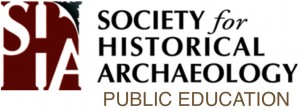 Over the last decade public archaeology in the UK has witnessed a growing profile. This is in part due to a steady stream of documentaries on the television and opportunities for the public to get involved. Public membership based organizations such as the Council for British Archaeology (CBA), have played a valuable role in providing opportunities for communal engagement. Meanwhile regional commercial archaeological units and not for profit Trusts have been developing educational resources to engage with school children and community groups. These kinds of projects have sought funding through the UK’s national Heritage Lottery Fund, National Heritage Agencies or organisations like the CBA.
Over the last decade public archaeology in the UK has witnessed a growing profile. This is in part due to a steady stream of documentaries on the television and opportunities for the public to get involved. Public membership based organizations such as the Council for British Archaeology (CBA), have played a valuable role in providing opportunities for communal engagement. Meanwhile regional commercial archaeological units and not for profit Trusts have been developing educational resources to engage with school children and community groups. These kinds of projects have sought funding through the UK’s national Heritage Lottery Fund, National Heritage Agencies or organisations like the CBA.
My role as Director of the Maritime Archaeology Trust (also known as the Hampshire and Wight Trust for Maritime Archaeology but forthwith referred to as the Trust) has been to precipitate a growth in public archaeology within the organisation and within the maritime archaeological sector. The Trust was inaugurated in 1991 with the objective of promoting archaeology in the region and Great Britain by research, training and education. It was set up by the civic authorities in Hampshire and the Isle of Wight at a time when there was a legislative void regarding holistic management of the submerged archaeological resource. Shipwrecks were being discovered and several were being excavated or even protected but collective management was yet to be considered. The Trust was formed to fill this vacuum in the region and it was set up with the belief that comparable organisations would be established across the country.
Throughout the 1990s core funding from the local authorities and central government enabled the listing of local wrecks, survey, excavation, the setting up of diver trails, the publication of booklets, and support for a local exhibition. Public involvement was strong but I realised there was a much larger audience that needed to have access to the world of underwater archaeology if broader public interest was to be sustained and with it, public support. This was becoming particularly pertinent as our core funding was being reduced each year.
The opportunity to increase awareness by developing a more sophisticated education and outreach programme came following 2002 when the UK’s National Heritage Act extended the powers of the Historic Buildings and Monuments Commission to encompass underwater archaeology within UK territorial waters for the first time. This coincided with a levy on aggregate extraction in territorial waters that provided funds for maritime research. In turn, this provided a source of funding for extended education and outreach programmes. A successful application by the HWTMA resulted in a range of teaching resources, activities and educational books aimed at young children aged between 7 and 11. The educational resources were taken to schools where interactive teaching aids were framed around the stories of shipwrecks and drowned lands. The courses included global issues including pollution, rising sea level and geography. Science and survey was interwoven into projects that linked directly to the teaching curriculum while the subject matter was constructed around familiar events to provide context within which the children could identify.
The education and outreach programme was supported by detailed research and complemented by academic publications that ensured the source material was at the forefront of current thinking. This was exemplified in a European project where international teams joined to investigate submerged archaeological sites. The results were translated into three languages and taught in schools from each nation who interacted through the internet with web based education tools. In the UK, a travelling maritime bus has been created to access schools and more remote environments. Here it has been used to provide a tangible teaching resource. The vivid display and dynamic teaching methods used have proved particularly effective at engaging with more challenging pupils and groups.
I would argue that an understanding of ones historical background gives people a connection with the past. It takes time for society to form, and while doing so, the story of its evolution is archived in its history and material remains. Reference to this resource can embellish lives by providing a longer term link with the historic environment and engendering a sense of place in a community. This breeds collective self confidence and a civic pride that is the bedrock of any stable society. In the current times of uncertainty the need for secure social cohesion is becoming ever more important and strong anchors to the past can provide a grounding that binds people together. These are the foundations that need to be laid if we hope to get common respect for our place and each other. All too frequently we see that people are more ready to do harm to those from whom they feel excluded and distant rather than members of their own community. I would advocate that public historical and archaeological education is a tool that can make the past accessible to a wide audience of people who would otherwise not be reached. Yet, if we do not read that record we cannot learn from it and understand the present – not to mention that we would be less able to learn from our mistakes.
As the current economic climate worsens, available funding from public sector sources is focusing more and more on statutory requirements. In the UK, support for public archaeology is not statutory and as such does not qualify for mandatory funding. However, as it is education, it is taken for granted by the public in the UK who expect the state to pay for it. As it is not mandatory, civic authorities do not cover the costs. So despite the improved profile we have seen over the last decade, public archaeology is now facing its greatest challenges.
Many excellent tools and delivery methods have been developed on both sides of the Atlantic since the turn of the centaury. Public enthusiasm exists but it remains somewhere in the ‘not quite ready to pay’ zone on the fringes of popular culture. The same applies to civic leaders who like to be affiliated when they can afford it but seldom recognise the deeper social benefits that underlie the subject. The issue now is one of sustainability. Should we look to communities at ground level to help fund activities they will be involved in? Should we pursue support from the public purse? Should we persuade commerce and industry that they would benefit from supporting the sector?
I fear we will not achieve long term sustainability unless high level decision makers can fully appreciate the value of history and archaeology. So, SHA members, how are we going to achieve that?
The 2013 Spring SHA Newsletter!
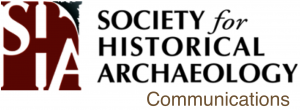 The 2013 Spring edition of the SHA Newsletter is now wending its way via mail to SHA members who receive the print version. Digital subscribers have had access for the last week. Content highlights this issue include the print version of the 2014 Québec City call for papers, and a summary of the 2013 SHA awards from Terry Majewski. There are also submissions from Student subcommittee, the Public Education and Interpretation Committee about the 2013 Leicester conference, and from the Governmental Affairs Committee on the work being undertaken on SHA’s behalf in lobbying the US Congress.
The 2013 Spring edition of the SHA Newsletter is now wending its way via mail to SHA members who receive the print version. Digital subscribers have had access for the last week. Content highlights this issue include the print version of the 2014 Québec City call for papers, and a summary of the 2013 SHA awards from Terry Majewski. There are also submissions from Student subcommittee, the Public Education and Interpretation Committee about the 2013 Leicester conference, and from the Governmental Affairs Committee on the work being undertaken on SHA’s behalf in lobbying the US Congress.
The regular Current Research and Images of the Past features have a particularly international flavor this issue, with Images of the Past touching on the roots of historical archaeology in Brazil, while Current Research includes articles on work in Austria, Sweden, the United Kingdom, Argentina and – demonstrating just how global historical is in both practice and themes – the Pacific island nation of Vanuatu. There are also plenty of current research contributions from the United States and Canada, so no one need feel left out.
The deadline for submissions to the summer issue is the 1st of June. If you have some news about current research you’d like to share with SHA’s increasingly global membership, consider getting in touch with your regional coordinator (see the Newsletter for contact details), who’ll be happy to help. Or if you have opinions about issues pertinent to historical archaeology you’d like to include in the Opinion and Debate section, please feel free to contact the Editor directly – I’ll likewise be happy to offer guidance on appropriate submissions.
Are you interested in receiving the SHA Newsletter? Anyone can access previous versions of the newsletter in the Newsletter Archive, but only SHA members can receive the most current issue. Join the SHA here, and get your newsletter before everyone else!






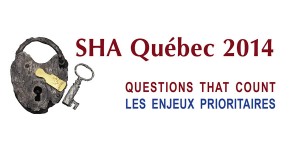


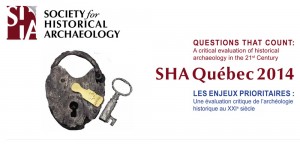
Pingback: WAC May 2012 eNewsletter – Volume 40 – World Archaeology Congress